概述
产品名称
HMGB1 Recombinant Rabbit Monoclonal Antibody [SA39-03]
抗体类型
Recombinant Rabbit monoclonal Antibody
免疫原
Synthetic peptide within Human HMGB1 aa 151-200 / 215.
种属反应性
Human, Mouse, Rat
验证应用
WB, IF-Cell, IF-Tissue, IHC-P, FC
分子量
Predicted band size: 25 kDa
阳性对照
HepG2 cell lysate, HeLa cell lysate, HCT 116 cell lysate, A549 cell lysate, Jurkat cell lysate, C2C12 cell lysate, C6 cell lysate, HeLa, mouse thymus tissue lysate, rat spleen tissue lysate, MCF-7, human tonsil tissue, human kidney tissue, mouse brain tissue, HCT 116, mouse hippocampus tissue.
偶联
unconjugated
克隆号
SA39-03
RRID
产品特性
形态
Liquid
浓度
1ug/ul
存放说明
Store at +4℃ after thawing. Aliquot store at -20℃ or -80℃. Avoid repeated freeze / thaw cycles.
存储缓冲液
1*TBS (pH7.4), 0.05% BSA, 40% Glycerol. Preservative: 0.05% Sodium Azide.
亚型
IgG
纯化方式
Protein A affinity purified.
应用稀释度
-
WB
-
1:20,000-1:50,000
-
IF-Cell
-
1:500
-
IF-Tissue
-
1:100
-
IHC-P
-
1:5,000-1:20,000
-
FC
-
1:1,000
发表文章中的应用
发表文章中的种属
| Mouse | See 5 publications below |
| Human | See 3 publications below |
| Rat | See 2 publications below |
靶点
功能
High mobility group box 1 protein, also known as high-mobility group protein 1 (HMG-1) and amphoterin, is a protein that in humans is encoded by the HMGB1 gene. HMG-1 belongs to the high mobility group and contains a HMG-box domain. Like the histones, HMGB1 is among the most important chromatin proteins. In the nucleus HMGB1 interacts with nucleosomes, transcription factors, and histones. This nuclear protein organizes the DNA and regulates transcription. After binding, HMGB1 bends DNA, which facilitates the binding of other proteins. HMGB1 supports transcription of many genes in interactions with many transcription factors. It also interacts with nucleosomes to loosen packed DNA and remodel the chromatin. Contact with core histones changes the structure of nucleosomes. The presence of HMGB1 in the nucleus depends on posttranslational modifications. When the protein is not acetylated, it stays in the nucleus, but hyperacetylation on lysine residues causes it to translocate into the cytosol. HMGB1 has been shown to play an important role in helping the RAG endonuclease form a paired complex during V(D)J recombination.
背景文献
1. "Novel role of PKR in inflammasome activation and HMGB1 release." Lu B., Nakamura T., Inouye K., Li J., Tang Y., Lundbaeck P., Valdes-Ferrer S.I., Olofsson P.S., Kalb T., Roth J., Zou Y., Erlandsson-Harris H., Yang H., Ting J.P., Wang H., Andersson U., Antoine D.J., Chavan S.S., Hotamisligil G.S., Tracey K.J. Nature 488:670-674(2012).
2. "The genetic variation of the human HMGB1 gene." Kornblit B., Munthe-Fog L., Petersen S., Madsen H., Vindeloev L., Garred P. Tissue Antigens 70:151-156(2007).
序列相似性
Belongs to the HMGB family.
组织特异性
Ubiquituous. Expressed in platelets.
翻译后修饰
Phosphorylated at serine residues. Phosphorylation in both NLS regions is required for cytoplasmic translocation followed by secretion.; Acetylated on multiple sites upon stimulation with LPS. Acetylation on lysine residues in the nuclear localization signals (NLS 1 and NLS 2) leads to cytoplasmic localization and subsequent secretion (By similarity). Acetylation on Lys-3 results in preferential binding to DNA ends and impairs DNA bending activity (By similarity).; Reduction/oxidation of cysteine residues Cys-23, Cys-45 and Cys-106 and a possible intramolecular disulfide bond involving Cys-23 and Cys-45 give rise to different redox forms with specific functional activities in various cellular compartments: 1- fully reduced HMGB1 (HMGB1C23hC45hC106h), 2- disulfide HMGB1 (HMGB1C23-C45C106h) and 3- sulfonyl HMGB1 (HMGB1C23soC45soC106so).; Poly-ADP-ribosylated by PARP1 when secreted following stimulation with LPS (By similarity).; In vitro cleavage by CASP1 is liberating a HMG box 1-containing peptide which may mediate immunogenic activity; the peptide antagonizes apoptosis-induced immune tolerance. Can be proteolytically cleaved by a thrombin:thrombomodulin complex; reduces binding to heparin and proinflammatory activities (By similarity).
亚细胞定位
Cytoplasm, Nucleus, Cell membrane, Secreted, Chromosome
别名
Amphoterin antibody
Chromosomal protein, nonhistone, HMG1 antibody
DKFZp686A04236 antibody
High mobility group 1 antibody
High mobility group box 1 antibody
High mobility group protein 1 antibody
High mobility group protein B1 antibody
high-mobility group (nonhistone chromosomal) protein 1 antibody
HMG-1 antibody
HMG1 antibody
展开Amphoterin antibody
Chromosomal protein, nonhistone, HMG1 antibody
DKFZp686A04236 antibody
High mobility group 1 antibody
High mobility group box 1 antibody
High mobility group protein 1 antibody
High mobility group protein B1 antibody
high-mobility group (nonhistone chromosomal) protein 1 antibody
HMG-1 antibody
HMG1 antibody
HMG3 antibody
HMGB 1 antibody
HMGB1 antibody
HMGB1_HUMAN antibody
NONHISTONE CHROMOSOMAL PROTEIN HMG1 antibody
SBP 1 antibody
Sulfoglucuronyl carbohydrate binding protein antibody
折叠图片
-
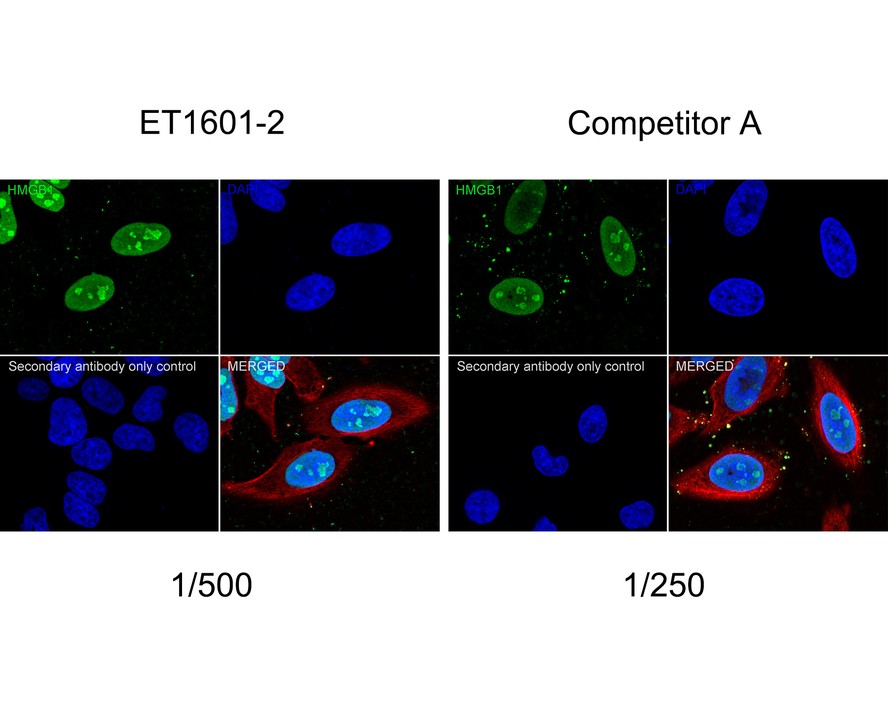
Immunocytochemistry analysis of HeLa cells labeling HMGB1 with Rabbit anti-HMGB1 antibody (ET1601-2) at 1/500 dilution and competitor's antibody at 1/250 dilution.
Cells were fixed in 4% paraformaldehyde for 20 minutes at room temperature, permeabilized with 0.1% Triton X-100 in PBS for 5 minutes at room temperature, then blocked with 1% BSA in 10% negative goat serum for 1 hour at room temperature. Cells were then incubated with Rabbit anti-HMGB1 antibody (ET1601-2) at 1/500 dilution and competitor's antibody at 1/250 dilution in 1% BSA in PBST overnight at 4 ℃. Goat Anti-Rabbit IgG H&L (iFluor™ 488, HA1121) was used as the secondary antibody at 1/1,000 dilution. PBS instead of the primary antibody was used as the secondary antibody only control. Nuclear DNA was labelled in blue with DAPI.
Beta tubulin (M1305-2, red) was stained at 1/100 dilution overnight at +4℃. Goat Anti-Mouse IgG H&L (iFluor™ 594, HA1126) was used as the secondary antibody at 1/1,000 dilution. -

Western blot analysis of HMGB1 on different lysates with Rabbit anti-HMGB1 antibody (ET1601-2) at 1/50,000 dilution and competitor's antibody at 1/10,000 dilution.
Lane 1: HepG2 cell lysate
Lane 2: HeLa cell lysate
Lane 3: HCT 116 cell lysate
Lane 4: A549 cell lysate
Lane 5: Jurkat cell lysate
Lane 6: C2C12 cell lysate
Lane 7: C6 cell lysate
Lysates/proteins at 15 µg/Lane.
Predicted band size: 25 kDa
Observed band size: 25 kDa
Exposure time: 21 seconds;
4-20% SDS-PAGE gel.
Proteins were transferred to a PVDF membrane and blocked with 5% NFDM/TBST for 1 hour at room temperature. The primary antibody (ET1601-2) at 1/50,000 dilution and competitor's antibody at 1/10,000 dilution were used in 5% NFDM/TBST at 4℃ overnight. Goat Anti-Rabbit IgG - HRP Secondary Antibody (HA1001) at 1/50,000 dilution was used for 1 hour at room temperature. -
![<span style="font-weight: bold;">☑ Knockout (KO)</span><br /><br />All lanes: Western blot analysis of HMGB1 with anti-HMGB1 antibody [SA39-03] (<a href="/products/ET1601-2" style="font-weight: bold;text-decoration: underline;">ET1601-2</a>) at 1:500 dilution.<br /><br />Lane 1: Wild-type Raw264.7 whole cell lysate.<br />Lane 2: HMGB1 knockout Raw264.7 whole cell lysate.<br /><br /><a href="/products/ET1601-2" style="font-weight: bold;text-decoration: underline;">ET1601-2</a> was shown to specifically react with HMGB1 in wild-type Raw264.7 cells. No band was observed when HMGB1 knockout samples were tested. Wild-type and HMGB1 knockout samples were subjected to SDS-PAGE. Proteins were transferred to a PVDF membrane and blocked with 5% NFDM in TBST for 1 hour at room temperature. The primary Anti-HMGB1 antibody (<a href="/products/ET1601-2" style="font-weight: bold;text-decoration: underline;">ET1601-2</a>, 1/500) and Anti-HSP90 antibody (<a href="/products/ET1605-56" style="font-weight: bold;text-decoration: underline;">ET1605-56</a>, 1/10,000) were used in 5% BSA at room temperature for 2 hours. Goat Anti-Rabbit IgG H&L (HRP) Secondary Antibody (<a href="/products/HA1001" style="font-weight: bold;text-decoration: underline;">HA1001</a>) at 1:200,000 dilution was used for 1 hour at room temperature.<br /><br />Cell lysate was provided by Ubigene Biosciences (Ubigene Biosciences Co., Ltd., Guangzhou, China).](http://storage.huabio.cn/huabio/productImg/ET1601-2_3.jpg?v=20241015165530)
☑ Knockout (KO)
All lanes: Western blot analysis of HMGB1 with anti-HMGB1 antibody [SA39-03] (ET1601-2) at 1:500 dilution.
Lane 1: Wild-type Raw264.7 whole cell lysate.
Lane 2: HMGB1 knockout Raw264.7 whole cell lysate.
ET1601-2 was shown to specifically react with HMGB1 in wild-type Raw264.7 cells. No band was observed when HMGB1 knockout samples were tested. Wild-type and HMGB1 knockout samples were subjected to SDS-PAGE. Proteins were transferred to a PVDF membrane and blocked with 5% NFDM in TBST for 1 hour at room temperature. The primary Anti-HMGB1 antibody (ET1601-2, 1/500) and Anti-HSP90 antibody (ET1605-56, 1/10,000) were used in 5% BSA at room temperature for 2 hours. Goat Anti-Rabbit IgG H&L (HRP) Secondary Antibody (HA1001) at 1:200,000 dilution was used for 1 hour at room temperature.
Cell lysate was provided by Ubigene Biosciences (Ubigene Biosciences Co., Ltd., Guangzhou, China). -

Western blot analysis of HMGB1 on different lysates with Rabbit anti-HMGB1 antibody (ET1601-2) at 1/20,000 dilution.
Lane 1: HeLa cell lysate (20 µg/Lane)
Lane 2: HCT 116 cell lysate (20 µg/Lane)
Lane 3: A549 cell lysate (20 µg/Lane)
Lane 4: HepG2 cell lysate (20 µg/Lane)
Lane 5: Jurkat cell lysate (20 µg/Lane)
Lane 6: Mouse thymus tissue lysate (20 µg/Lane)
Lane 7: Rat spleen tissue lysate (30 µg/Lane)
Predicted band size: 25 kDa
Observed band size: 25 kDa
Exposure time: 3 minutes 10 seconds;
4-20% SDS-PAGE gel.
Proteins were transferred to a PVDF membrane and blocked with 5% NFDM/TBST for 1 hour at room temperature. The primary antibody (ET1601-2) at 1/20,000 dilution was used in 5% NFDM/TBST at 4℃ overnight. Goat Anti-Rabbit IgG - HRP Secondary Antibody (HA1001) at 1/50,000 dilution was used for 1 hour at room temperature. -

Immunocytochemistry analysis of MCF-7 cells labeling HMGB1 with Rabbit anti-HMGB1 antibody (ET1601-2) at 1/100 dilution.
Cells were fixed in 4% paraformaldehyde for 10 minutes at 37 ℃, permeabilized with 0.05% Triton X-100 in PBS for 20 minutes, and then blocked with 2% negative goat serum for 30 minutes at room temperature. Cells were then incubated with Rabbit anti-HMGB1 antibody (ET1601-2) at 1/100 dilution in 2% negative goat serum overnight at 4 ℃. Goat Anti-Rabbit IgG H&L (iFluor™ 488, HA1121) was used as the secondary antibody at 1/1,000 dilution. PBS instead of the primary antibody was used as the secondary antibody only control. Nuclear DNA was labelled in blue with DAPI. -

Immunohistochemical analysis of paraffin-embedded human kidney tissue with Rabbit anti-HMGB1 antibody (ET1601-2) at 1/20,000 dilution.
The section was pre-treated using heat mediated antigen retrieval with sodium citrate buffer (pH 6.0) for 2 minutes. The tissues were blocked in 1% BSA for 20 minutes at room temperature, washed with ddH2O and PBS, and then probed with the primary antibody (ET1601-2) at 1/20,000 dilution for 1 hour at room temperature. The detection was performed using an HRP conjugated compact polymer system. DAB was used as the chromogen. Tissues were counterstained with hematoxylin and mounted with DPX. -

Immunohistochemical analysis of paraffin-embedded mouse brain tissue with Rabbit anti-HMGB1 antibody (ET1601-2) at 1/20,000 dilution.
The section was pre-treated using heat mediated antigen retrieval with sodium citrate buffer (pH 6.0) for 2 minutes. The tissues were blocked in 1% BSA for 20 minutes at room temperature, washed with ddH2O and PBS, and then probed with the primary antibody (ET1601-2) at 1/20,000 dilution for 1 hour at room temperature. The detection was performed using an HRP conjugated compact polymer system. DAB was used as the chromogen. Tissues were counterstained with hematoxylin and mounted with DPX. -

Immunohistochemical analysis of paraffin-embedded mouse hippocampus tissue with Rabbit anti-HMGB1 antibody (ET1601-2) at 1/20,000 dilution.
The section was pre-treated using heat mediated antigen retrieval with sodium citrate buffer (pH 6.0) for 2 minutes. The tissues were blocked in 1% BSA for 20 minutes at room temperature, washed with ddH2O and PBS, and then probed with the primary antibody (ET1601-2) at 1/20,000 dilution for 1 hour at room temperature. The detection was performed using an HRP conjugated compact polymer system. DAB was used as the chromogen. Tissues were counterstained with hematoxylin and mounted with DPX. -

Immunohistochemical analysis of paraffin-embedded rat brain tissue with Rabbit anti-HMGB1 antibody (ET1601-2) at 1/20,000 dilution.
The section was pre-treated using heat mediated antigen retrieval with sodium citrate buffer (pH 6.0) for 2 minutes. The tissues were blocked in 1% BSA for 20 minutes at room temperature, washed with ddH2O and PBS, and then probed with the primary antibody (ET1601-2) at 1/20,000 dilution for 1 hour at room temperature. The detection was performed using an HRP conjugated compact polymer system. DAB was used as the chromogen. Tissues were counterstained with hematoxylin and mounted with DPX. -

Immunohistochemical analysis of paraffin-embedded rat hippocampus tissue with Rabbit anti-HMGB1 antibody (ET1601-2) at 1/20,000 dilution.
The section was pre-treated using heat mediated antigen retrieval with sodium citrate buffer (pH 6.0) for 2 minutes. The tissues were blocked in 1% BSA for 20 minutes at room temperature, washed with ddH2O and PBS, and then probed with the primary antibody (ET1601-2) at 1/20,000 dilution for 1 hour at room temperature. The detection was performed using an HRP conjugated compact polymer system. DAB was used as the chromogen. Tissues were counterstained with hematoxylin and mounted with DPX. -

"Immunocytochemistry analysis of C2C12 cells labeling HMGB1 with Rabbit anti-HMGB1 antibody (ET1601-2) at 1/500 dilution.
Cells were fixed in 4% paraformaldehyde for 20 minutes at room temperature, permeabilized with 0.1% Triton X-100 in PBS for 5 minutes at room temperature, then blocked with 1% BSA in 10% negative goat serum for 1 hour at room temperature. Cells were then incubated with Rabbit anti-HMGB1 antibody (ET1601-2) at 1/500 dilution in 1% BSA in PBST overnight at 4 ℃. Goat Anti-Rabbit IgG H&L (iFluor™ 488, HA1121) was used as the secondary antibody at 1/1,000 dilution. PBS instead of the primary antibody was used as the secondary antibody only control. Nuclear DNA was labelled in blue with DAPI.
Beta tubulin (M1305-2, red) was stained at 1/100 dilution overnight at +4℃. Goat Anti-Mouse IgG H&L (iFluor™ 594, HA1126) was used as the secondary antibody at 1/1,000 dilution. -

Immunocytochemistry analysis of C6 cells labeling HMGB1 with Rabbit anti-HMGB1 antibody (ET1601-2) at 1/500 dilution.
Cells were fixed in 4% paraformaldehyde for 20 minutes at room temperature, permeabilized with 0.1% Triton X-100 in PBS for 5 minutes at room temperature, then blocked with 1% BSA in 10% negative goat serum for 1 hour at room temperature. Cells were then incubated with Rabbit anti-HMGB1 antibody (ET1601-2) at 1/500 dilution in 1% BSA in PBST overnight at 4 ℃. Goat Anti-Rabbit IgG H&L (iFluor™ 488, HA1121) was used as the secondary antibody at 1/1,000 dilution. PBS instead of the primary antibody was used as the secondary antibody only control. Nuclear DNA was labelled in blue with DAPI.
Beta tubulin (M1305-2, red) was stained at 1/100 dilution overnight at +4℃. Goat Anti-Mouse IgG H&L (iFluor™ 594, HA1126) was used as the secondary antibody at 1/1,000 dilution. -

Flow cytometric analysis of HCT 116 cells labeling HMGB1.
Cells were fixed and permeabilized. Then stained with the primary antibody (ET1601-2, 1/1,000) (red) compared with Rabbit IgG Isotype Control (green). After incubation of the primary antibody at +4℃ for an hour, the cells were stained with a iFluor™ 488 conjugate-Goat anti-Rabbit IgG Secondary antibody (HA1121) at 1/1,000 dilution for 30 minutes at +4℃. Unlabelled sample was used as a control (cells without incubation with primary antibody; black).
Please note: All products are "FOR RESEARCH USE ONLY AND ARE NOT INTENDED FOR DIAGNOSTIC OR THERAPEUTIC USE"
引文
-
Triggering Pyroptosis by Doxorubicin-Loaded Multifunctional Nanoparticles in Combination with Decitabine for Breast Cancer Chemoimmunotherapy
Author: Xueyan Hou,et al
PMID: NO PMID 2024102508
应用: IF
反应种属: human
发表时间: 2024 Oct
-
Citation
-
Ursolic acid improves necroptosis via STAT3 signaling in intestinal ischemia/reperfusion injury
Author: Shi Yajing,et al
PMID: 38971110
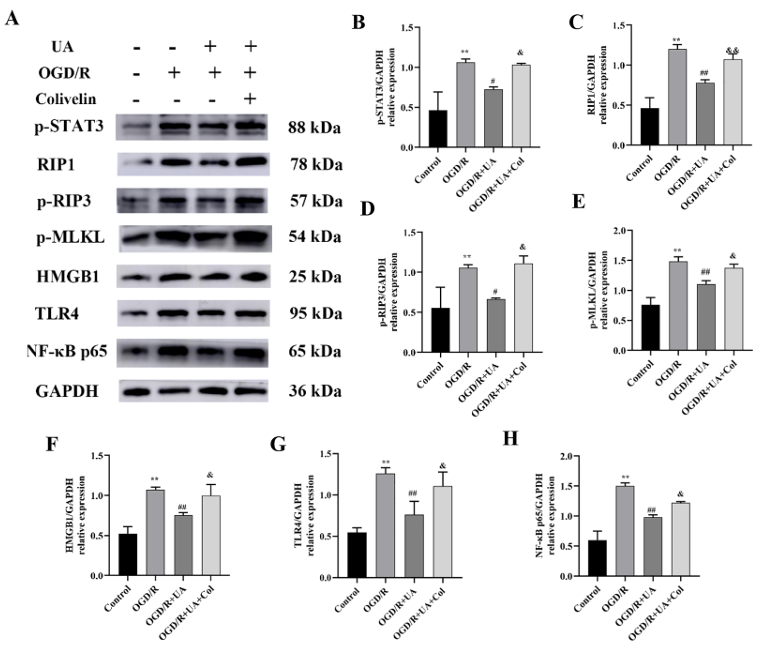
应用: WB
反应种属: Mouse
发表时间: 2024 Jul
-
Citation
-
Injectable alginate hydrogel promotes antitumor immunity through glucose oxidase and Fe3+ amplified RSL3-induced ferroptosis
Author: Chen K, Gu L, Zhang Q, et al
PMID: 38142082
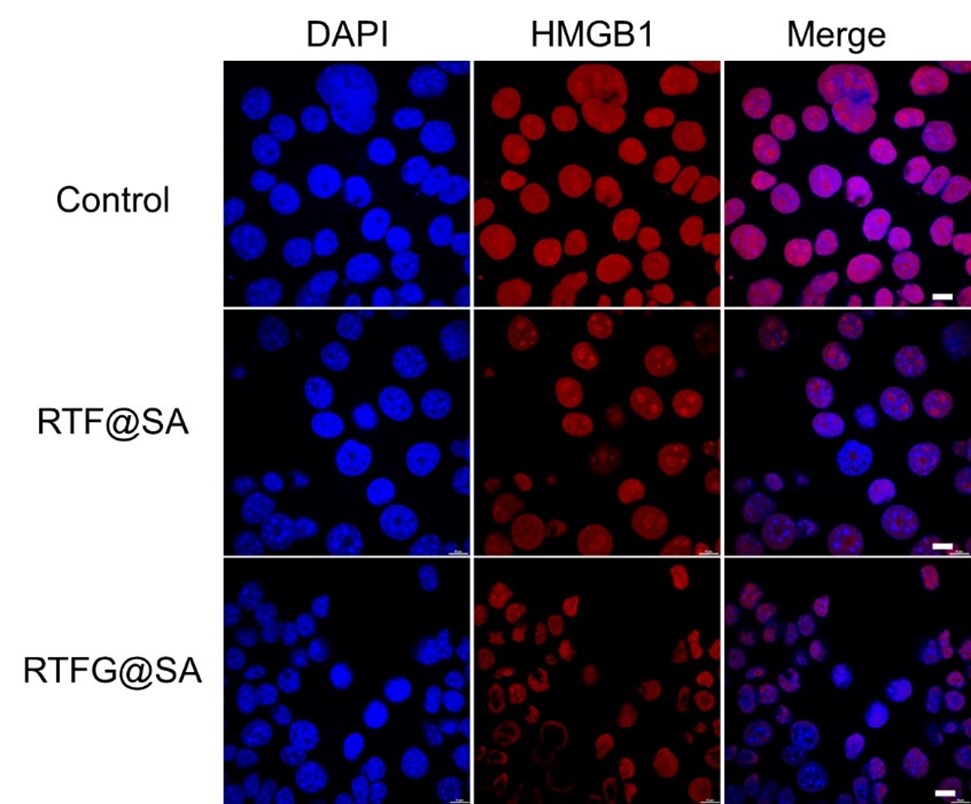
应用: IF-Cell
反应种属: Mouse
发表时间: 2024 Feb
-
Citation
-
Fingolimod Alleviates Inflammation after Cerebral Ischemia via HMGB1/TLR4/NF‑κB Signaling Pathway
Author: Xing Yao,et al
PMID: NO PMID20240818
应用: IHC,WB
反应种属: Rat
发表时间: 2024 Aug
-
Citation
-
Grass carp Il-2 promotes neutrophil extracellular traps formation via inducing ROS production and autophagy in vitro
Author: Lv M, Wang Y, Yu J, et al
PMID: 38040137
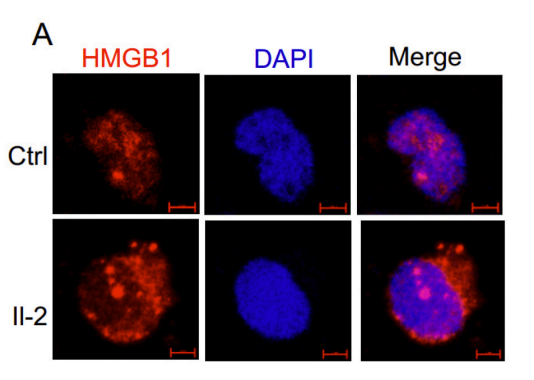
应用: IF
反应种属: Grass carp
发表时间: 2023 Nov
-
Citation
-
mTOR signaling pathway regulates embryonic development and rapid growth of triploid crucian carp
Author: Huang Z , Dai L, Peng F,et al
PMID: NO PMID202311
应用:
反应种属: Mouse
发表时间: 2023 Nov
-
Citation
-
Lipid–Polymer Hybrid Nanoparticles with Both PD-L1 Knockdown and Mild Photothermal Effect for Tumor Photothermal Immunotherapy
Author:
PMID: 37605506
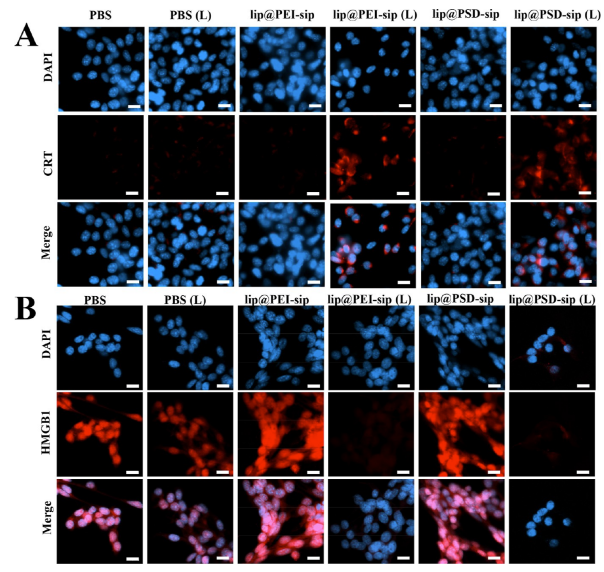
应用: IF
反应种属: Mouse
发表时间: 2023
-
Citation
-
SARS-CoV-2 ORF3a induces RETREG1/FAM134B dependent reticulophagy and triggers sequential ER stress and inflammatory responses during SARS-CoV-2 infection
Author: Zhang, X., Yang, Z., Pan, T., Long, X., Sun, Q., Wang, P. H., Li, X., & Kuang, E.
PMID: 35239449
应用: WB
反应种属: Human
发表时间: 2022 Mar
-
Citation
-
Reduced HMGB1 expression contributed to lapatinib-induced cutaneous injury
Author:
PMID: NA1
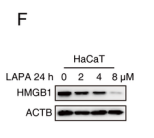
应用: WB
反应种属: Human
发表时间: 2022 Mar
-
Citation
-
Decreased HMGB1 expression contributed to cutaneous toxicity caused by lapatinib
Author:
PMID: 35617997
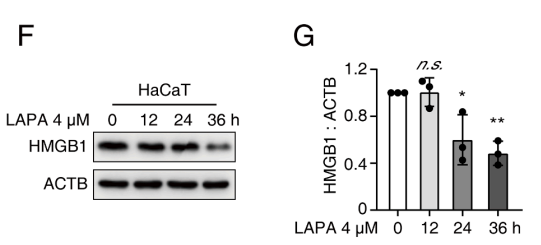
应用: WB
反应种属: Human
发表时间: 2022 Jul
-
Citation
-
Ginsenoside Rh2 Inhibits NLRP3 Inflammasome Activation and Improves Exosomes to Alleviate Hypoxia-Induced Myocardial Injury
Author:
PMID: 35865525
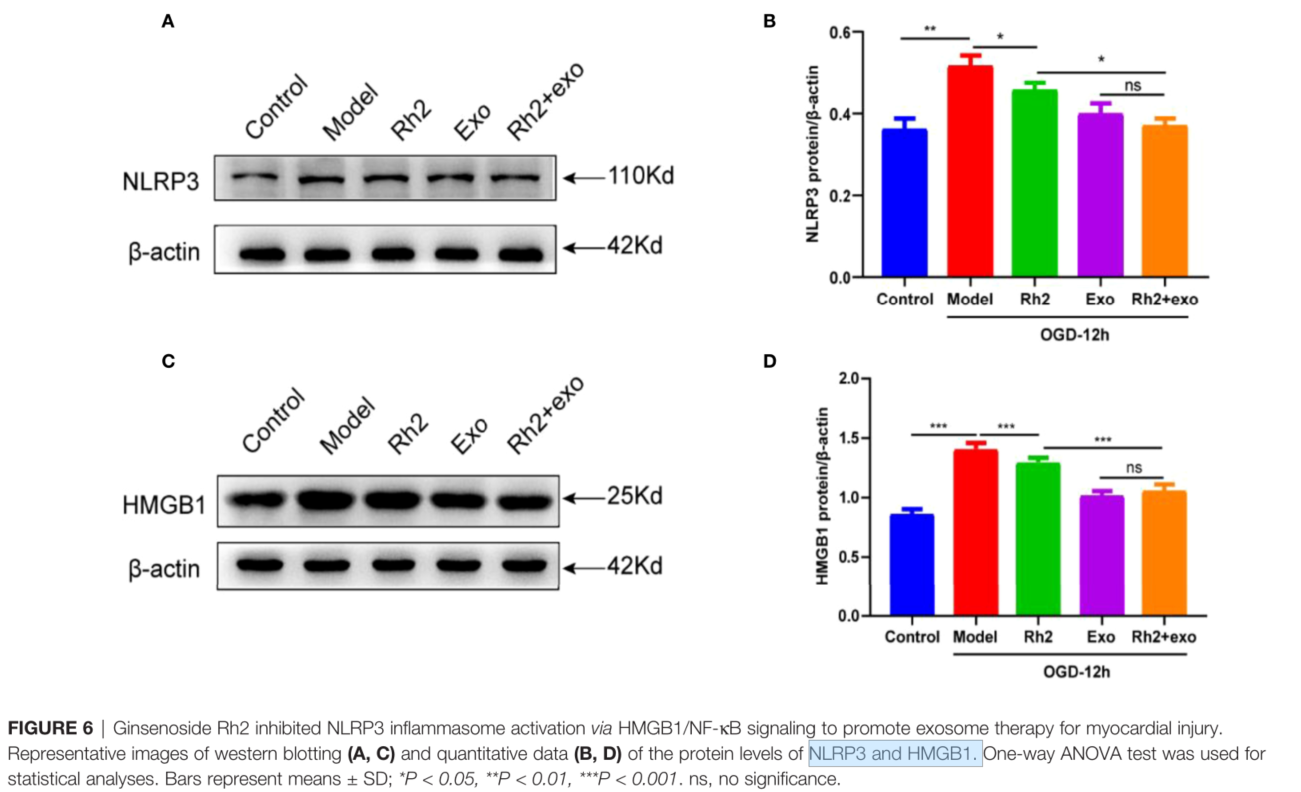
应用: WB
反应种属: Rat
发表时间: 2022 Jul
-
Citation
-
Autophagic degradation of CCN2 (cellular communication network factor 2) causes cardiotoxicity of sunitinib
Author: Xu, Z., Jin, Y., Gao, Z., Zeng, Y., Du, J., Yan, H., Chen, X., Ping, L., Lin, N., Yang, B., He, Q., & Luo, P.
PMID: 34432562

应用: IF
反应种属: Mouse
发表时间: 2021 Aug
-
Citation
同靶点&同通路的产品
HMGB1 Rabbit Polyclonal Antibody
Application: WB,IF-Cell,IHC-P,FC
Reactivity: Human,Mouse,Rat
Conjugate: unconjugated
HMGB1 Rabbit Polyclonal Antibody
Application: WB,IF-Cell,IHC-P,FC
Reactivity: Human,Mouse,Rat
Conjugate: unconjugated





